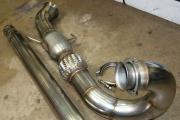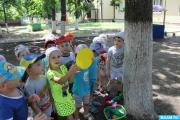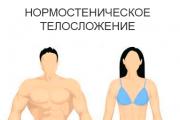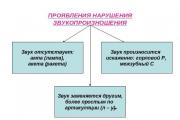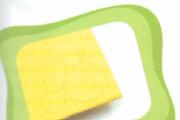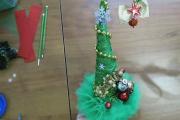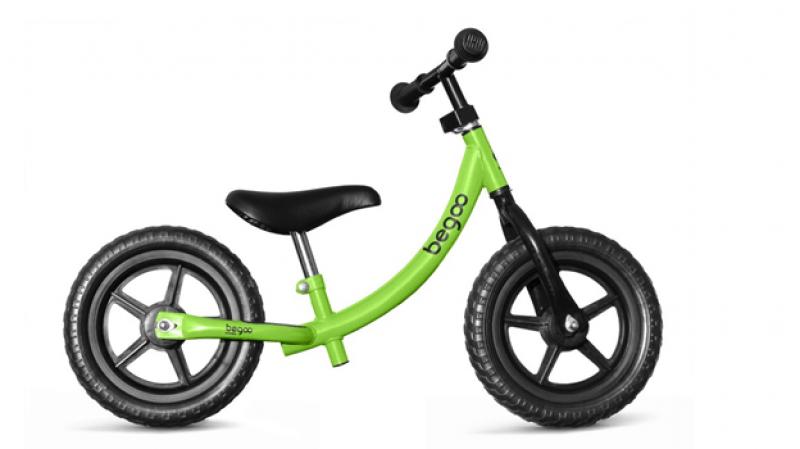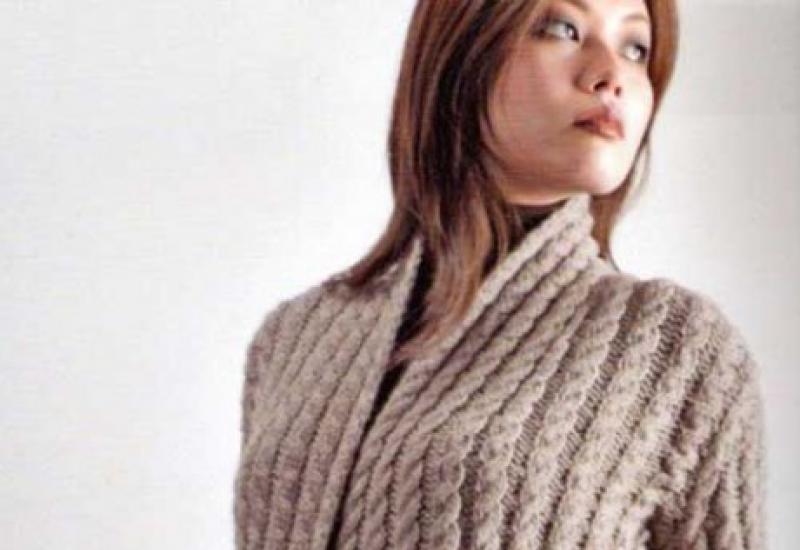New Year's decorations. Reindeer for Santa Claus
The following work submitted to the competition was made using the modular origami technique. Products using this technique are known to be labor-intensive, because creating even the most complex figures can require several hundred basic modules. At the same time, the process of folding the modules (classic origami) and connecting them to each other is extremely simple, and making such a reindeer from paper is quite within the capabilities of 3rd and 4th grade students. And the author of this work, Lyudmila Prishchenko, will help you understand the modular intricacies.
Reindeer for Santa Claus
This master class is intended for children who are interested in modular origami.
The origami figures are based on a simple module that can be folded by children from the age of five.
Triangular origami module.
Fold a rectangular piece of paper in half lengthwise. Then bend it across to mark the middle of the line and straighten it out.
Place the longitudinal fold away from you and fold the edges towards the middle. Turn the part over.
Fold in the bottom corners. Fold the bottom up. And fold the workpiece in half.
The triangular origami module is ready.

Reindeer.
Once you have sorted out the folding of the basic triangular module, you can begin making the Reindeer figure.
This work can be completed by students in grades 3-4. The finished paper toy can be given to friends and parents. It can also become a Christmas tree decoration or interior decoration for the New Year.
I would like to start the master class with a poem about a reindeer.
I’ll go to distant lands -
Thought the reindeer,
I'll go where it's good
Where the sun shines and warmth,
Where will I meet good friends?
And it will immediately become more fun!
I'm standing here alone
Among the swampy bogs.
The process of doing work.
To work you will need 766 white modules and 92 beige modules. We divide the A4 sheet into 32 rectangles and cut them, from the finished rectangles we make modules.

For the 1st and 2nd rows, take 6 white modules and connect them into a ring.
In the 3rd row we add 6 modules. To do this, we put one module on each corner of the triangle. It turns out 12 white modules.
In the 4th row we put on 12 modules as usual.

In the 5th row we add 12 modules in the same way as in the 3rd row. All modules are white. And so it turns out 24 modules.
Next we continue to put on 24 modules.
Row 6 – 24 modules
Row 7 – 24 modules
Row 8 – 24 modules
9 row – 24 modules
10 row – 24 modules
11 row – 24 modules
12 row – 24 modules
13 row – 24 modules

14 row – 24 modules
15 row – 24 modules
16 row – 24 modules
17 row – 24 modules
18 row – 24 modules
19 row – 24 modules
20 row – 24 modules
21 row – 24 modules
22 row – 24 modules
Each time we use our fingers to bring the modules as close to each other as possible.

Let's start making the neck.


Deer tail.
The sequence of alternating modules is: 1 – 2 – 3 – 2 – 3.

Glue the assembled tail to the body.

The origami deer head is assembled in the same way as the body, but there should be 5 modules in the 1st and 2nd rows. In the 3rd row we add 5 modules, in the 4th row - 10 modules.
In the 5th row we again add 5 modules. 6, 7, 8, 9 rows - 15 modules each.

We continue to assemble the head.
10, 11, 12 rows - 15 modules each on the short side. In the 13th row we decrease 5 modules. We put 1 module on 3 corners. This makes 10 modules.
The head is ready.

Glue the head to the neck. The photo shows how this should be done.

Now let's start making the legs.
For one leg you will need 18 white and 7 beige modules. The legs are assembled according to the following pattern: 2 – 1 – 2 – 1 – 2 – 1 – 2 – 1 – 2.
To make the hooves, we put on the modules with the short side: 3 white modules, 2 beige, 3 beige and 2 beige modules.
We make 4 legs in this way.

Antler.
To assemble the horns you will need 44 beige modules. The photo shows how to put on the modules:

Cut out the eyes, nose and glue.

And in conclusion, I offer children's riddles about a deer.
I. Zakharova
In the Tundra he lives cold.
It's frosty and snowy there.
Silent, noble.
Wears horns.
He should look for moss under the snow
There will never be laziness.
And in harness at a brisk run
Rushing... (Reindeer)
G. Stupnikov
He lives in the north
Dense snow hits with a hoof
Pinches moss all day long...
What's his name? ... (Deer)
V. Laktionov
He shovels deep snow,
And he gets delicious reindeer moss,
He sometimes digs all day
Arctic northern... (deer)
E. Shushkovskaya
He lives in the North
The sled is driving through the snow,
He wears his horns proudly,
He is not afraid of a blizzard.
In the cold all day,
This is...(Reindeer)
Thanks everyone for your attention. Let the Reindeer bring you Santa Claus, who will fulfill all your wishes in the New Year 2014!
* * *
Lyudmila, thank you for the interesting and detailed master class! In essence, it turned out to be a ready-made plan for creative activities with children for parents and teachers. All that remains is to get together and make your own Reindeer, which will certainly fulfill your wonderful wish. =)
For our part, we wish you inexhaustible inspiration and much, much joy from creativity and pride in the success of your students!
1. Little deer.
2.TORSO
Let's start assembling the deer's body. We install the modules as shown in the photo. (we put the module on the long side with the long side)

3. For the first and second rows, take 6 modules each, connect them into a ring and close

4. In the third row, we put two modules on each module, inserting the corners into the internal pockets. It turns out that in the third row there are 12 modules.

5. In the fourth row we put on 12 modules.

6. In the fifth row, we again put two modules on each module (in the outer pockets). This makes 24 modules.


8. You should end up with “something similar to a flask” :))) Unfortunately, there is no intermediate photo. Therefore, I show the torso + neck + small tail :))

9.NECK
First, let's determine the place where our Deer's neck will grow.
And then we proceed to assembling the neck. We alternate the modules in this way: 6-5-6-5-6-5-4-3-4-3-4, slightly bending the entire neck back, pressing it to the body. (For reliability, I attached it to the body using a heat gun)


11.

12. This is what the neck looks like from above.

13. HEAD
The head is assembled according to the principle of the body. But only in the first and second row we take 5 modules. In the third and fourth rows there are 10 modules each, and in the fifth - twelfth rows there are already 15 modules. And in the last row there are again 10 modules.
And one more important point when assembling the Head. Starting from the 10th row and up to the 13th row, we put the modules on with the reverse side

14. I do the narrowing like this: I put one module on the three ends of the modules of the previous row.
Attention! This photo is for reference, it does not belong to the “deer” :)))
The following work submitted to the competition was made using the modular origami technique. Products using this technique are known to be labor-intensive, because creating even the most complex figures can require several hundred basic modules. At the same time, the process of folding the modules (classic origami) and connecting them to each other is extremely simple, and making such a reindeer from paper is quite within the capabilities of 3rd and 4th grade students. And the author of this work, Lyudmila Prishchenko, will help you understand the modular intricacies.
Reindeer for Santa Claus
This master class is intended for children who are interested in modular origami.
The origami figures are based on a simple module that can be folded by children from the age of five.
Triangular origami module.
Fold a rectangular piece of paper in half lengthwise. Then bend it across to mark the middle of the line and straighten it out.
Place the longitudinal fold away from you and fold the edges towards the middle. Turn the part over.
Fold in the bottom corners. Fold the bottom up. And fold the workpiece in half.
The triangular origami module is ready.

Reindeer.
Once you have sorted out the folding of the basic triangular module, you can begin making the Reindeer figure.
This work can be completed by students in grades 3-4. The finished paper toy can be given to friends and parents. It can also become a Christmas tree decoration or interior decoration for the New Year.
I would like to start the master class with a poem about a reindeer.
I’ll go to distant lands -
Thought the reindeer,
I'll go where it's good
Where the sun shines and warmth,
Where will I meet good friends?
And it will immediately become more fun!
I'm standing here alone
Among the swampy bogs.
The process of doing work.
To work you will need 766 white modules and 92 beige modules. We divide the A4 sheet into 32 rectangles and cut them, from the finished rectangles we make modules.

For the 1st and 2nd rows, take 6 white modules and connect them into a ring.
In the 3rd row we add 6 modules. To do this, we put one module on each corner of the triangle. It turns out 12 white modules.
In the 4th row we put on 12 modules as usual.

In the 5th row we add 12 modules in the same way as in the 3rd row. All modules are white. And so it turns out 24 modules.
Next we continue to put on 24 modules.
Row 6 – 24 modules
Row 7 – 24 modules
Row 8 – 24 modules
9 row – 24 modules
10 row – 24 modules
11 row – 24 modules
12 row – 24 modules
13 row – 24 modules

14 row – 24 modules
15 row – 24 modules
16 row – 24 modules
17 row – 24 modules
18 row – 24 modules
19 row – 24 modules
20 row – 24 modules
21 row – 24 modules
22 row – 24 modules
Each time we use our fingers to bring the modules as close to each other as possible.

Let's start making the neck.


Deer tail.
The sequence of alternating modules is: 1 – 2 – 3 – 2 – 3.

Glue the assembled tail to the body.

The origami deer head is assembled in the same way as the body, but there should be 5 modules in the 1st and 2nd rows. In the 3rd row we add 5 modules, in the 4th row - 10 modules.
In the 5th row we again add 5 modules. 6, 7, 8, 9 rows - 15 modules each.

We continue to assemble the head.
10, 11, 12 rows - 15 modules each on the short side. In the 13th row we decrease 5 modules. We put 1 module on 3 corners. This makes 10 modules.
The head is ready.

Glue the head to the neck. The photo shows how this should be done.

Now let's start making the legs.
For one leg you will need 18 white and 7 beige modules. The legs are assembled according to the following pattern: 2 – 1 – 2 – 1 – 2 – 1 – 2 – 1 – 2.
To make the hooves, we put on the modules with the short side: 3 white modules, 2 beige, 3 beige and 2 beige modules.
We make 4 legs in this way.

Antler.
To assemble the horns you will need 44 beige modules. The photo shows how to put on the modules:

Cut out the eyes, nose and glue.

And in conclusion, I offer children's riddles about a deer.
I. Zakharova
In the Tundra he lives cold.
It's frosty and snowy there.
Silent, noble.
Wears horns.
He should look for moss under the snow
There will never be laziness.
And in harness at a brisk run
Rushing... (Reindeer)
G. Stupnikov
He lives in the north
Dense snow hits with a hoof
Pinches moss all day long...
What's his name? ... (Deer)
V. Laktionov
He shovels deep snow,
And he gets delicious reindeer moss,
He sometimes digs all day
Arctic northern... (deer)
E. Shushkovskaya
He lives in the North
The sled is driving through the snow,
He wears his horns proudly,
He is not afraid of a blizzard.
In the cold all day,
This is...(Reindeer)
Thanks everyone for your attention. Let the Reindeer bring you Santa Claus, who will fulfill all your wishes in the New Year 2014!
* * *
Lyudmila, thank you for the interesting and detailed master class! In essence, it turned out to be a ready-made plan for creative activities with children for parents and teachers. All that remains is to get together and make your own Reindeer, which will certainly fulfill your wonderful wish. =)
For our part, we wish you inexhaustible inspiration and much, much joy from creativity and pride in the success of your students!
The following work submitted to the competition was made using the modular origami technique. Products using this technique are known to be labor-intensive, because creating even the most complex figures can require several hundred basic modules. At the same time, the process of folding the modules (classic origami) and connecting them to each other is extremely simple, and making such a reindeer from paper is quite within the capabilities of 3rd and 4th grade students. And the author of this work, Lyudmila Prishchenko, will help you understand the modular intricacies.
Reindeer for Santa Claus
This master class is intended for children who are interested in modular origami.
The origami figures are based on a simple module that can be folded by children from the age of five.
Triangular origami module.
Fold a rectangular piece of paper in half lengthwise. Then bend it across to mark the middle of the line and straighten it out.
Place the longitudinal fold away from you and fold the edges towards the middle. Turn the part over.
Fold in the bottom corners. Fold the bottom up. And fold the workpiece in half.
The triangular origami module is ready.

Reindeer.
Once you have sorted out the folding of the basic triangular module, you can begin making the Reindeer figure.
This work can be completed by students in grades 3-4. The finished paper toy can be given to friends and parents. It can also become a Christmas tree decoration or interior decoration for the New Year.
I would like to start the master class with a poem about a reindeer.
I’ll go to distant lands, thought the reindeer, I’ll go where it’s good, Where the sun and warmth shine, Where I’ll meet good friends And it will immediately become more fun! And I’m standing here alone Among the swampy bogs. The process of doing work.
To work you will need 766 white modules and 92 beige modules. We divide the A4 sheet into 32 rectangles and cut them, from the finished rectangles we make modules.

For the 1st and 2nd rows, take 6 white modules and connect them into a ring.
In the 3rd row we add 6 modules. To do this, we put one module on each corner of the triangle. It turns out 12 white modules.
In the 4th row we put on 12 modules as usual.

In the 5th row we add 12 modules in the same way as in the 3rd row. All modules are white. And so it turns out 24 modules. Next we continue to put on 24 modules.
Row 6 – 24 modules
Row 7 – 24 modules
Row 8 – 24 modules
9 row – 24 modules
10 row – 24 modules
11 row – 24 modules
12 row – 24 modules
13 row – 24 modules

14 row – 24 modules
15 row – 24 modules
16 row – 24 modules
17 row – 24 modules
18 row – 24 modules
19 row – 24 modules
20 row – 24 modules
21 row – 24 modules
22 row – 24 modules
Each time we use our fingers to bring the modules as close to each other as possible.

Let's start making the neck.


Deer tail.
The sequence of alternating modules is: 1 – 2 – 3 – 2 – 3.

Glue the assembled tail to the body.

The origami deer head is assembled in the same way as the body, but there should be 5 modules in the 1st and 2nd rows. In the 3rd row we add 5 modules, in the 4th row - 10 modules.
In the 5th row we again add 5 modules. 6, 7, 8, 9 rows - 15 modules each.

We continue to assemble the head.
10, 11, 12 rows - 15 modules each on the short side. In the 13th row we decrease 5 modules. We put 1 module on 3 corners. This makes 10 modules.
The head is ready.

Glue the head to the neck. The photo shows how this should be done.

Now let's start making the legs.
For one leg you will need 18 white and 7 beige modules. The legs are assembled according to the following pattern: 2 – 1 – 2 – 1 – 2 – 1 – 2 – 1 – 2.
To make the hooves, we put on the modules with the short side: 3 white modules, 2 beige, 3 beige and 2 beige modules.
We make 4 legs in this way.

Antler.
To assemble the horns you will need 44 beige modules. The photo shows how to put on the modules:

Cut out the eyes, nose and glue.

And in conclusion, I offer children's riddles about a deer.
I. Zakharova
In the Tundra he lives cold. It's frosty and snowy there. Silent, noble. Wears horns. He will never be too lazy to look for moss under the snow. And in a harness he rushes at a fast pace... (Reindeer)
G. Stupnikov
He lives in the north, Beats the dense snow with his hoof, Pinches moss all day long... What is his name? … (Deer)
V. Laktionov
He shovels deep snow, And gets tasty reindeer moss, Sometimes he digs all day long, Polar... (deer)
E. Shushkovskaya
He lives in the North, Pulls a sled through the snow, He wears his horns proudly, He is not afraid of a blizzard. In the cold all day, This is... (Reindeer)
Thanks everyone for your attention. Let the Reindeer bring you Santa Claus, who will fulfill all your wishes in the New Year 2014!
* * *
Lyudmila, thank you for the interesting and detailed master class! In essence, it turned out to be a ready-made plan for creative activities with children for parents and teachers. All that remains is to get together and make your own Reindeer, which will certainly fulfill your wonderful wish. =)
For our part, we wish you inexhaustible inspiration and much, much joy from creativity and pride in the success of your students!
All competition entries
Word Origami comes from two words ori means "folding", and kami means "paper". This is the traditional Japanese art of folding various paper sculptures. The art of origami began to develop in the 17th century. AD in Japan, and in our time has spread widely across all continents and countries.
When folding models, they often try to follow a certain assembly pattern worked out by previously famous origami masters. For you, we tried to collect the best origami schemes in one place.
Photo frame
Photo frame in handmade style. It’s always great to make a frame for your favorite photos with your own hands, giving them your favorite color, texture and even decorating them to your taste. Such a frame, together with your photo, can become a gift for loved ones and give them warmth.

Simply a magnificent Frog from the famous orima master - Kawasaki. She is so funny that she will definitely make you smile. By the way, it can also be used as themed origami for Halloween.

This is an example of simple origami from a square sheet of paper; such bright leaves can even be made from a sticker. An easy-to-make little miracle that can be used in decorations, appliqués and interiors.

The scheme is easy to implement, just a few minutes and you have such beauty in your hands! Two swans have always been a symbol of good luck in love, hearts beating in unison. This card can also act as a talisman to attract your partner.

This bunny was designed to fold Vietnamese money, which has an aspect ratio close to 1X2. You can also use a square of two-color paper...

A beautiful kirigami postcard with dolphins swimming inside. The postcard is very easy to make and will definitely give you a sea mood.
Vase made from one sheet of paper
Very simple instructions for an origami vase. To make a vase, use a square sheet of thick paper at least 25 cm in size.

Wedding carriage in kirigami style. When making this model, use thick paper, otherwise the carriage may turn out flimsy and unstable.

Wedding angels always look very cute and beautiful. By making them from paper in the kirigami style, you will definitely add some zest to a romantic evening.

Very original origami instructions for a swan from the master Roman Diaz. The author's detailed explanations for each step should make folding this swan easier.
Origami super arrow plane.

A very simple paper airplane model. Take just seven steps and it's in your hands.

Square origami box. This model is quite simple and can be made by many craftsmen. The base of the box and the lid are folded according to one instruction. For a complete box with a lid, you will need 8 square sheets of origami paper.
3D origami – Reichstag

Another very complex model of architectural 3D origami is the Reichstag. To complete this model you need to be patient and have at least basic knowledge of the kirigami technique.

Pagoda - A multi-tiered tower used as a temple. Quite a complex kirigami model, but very original. The pillar pagoda contains small details and you will have to work hard to replicate it on paper.
Tea bag deer

Origami deer from a tea bag by Jun Maekawa. The diagram is simple, and the instructions are very detailed. Such a paper miracle with a morning cup of tea always lifts your spirits.
Octagonal origami box

Origami frog by Jun Mayakawa.

Convenient instructions and high-quality pictures will be your assistants. The scheme is complex, you need to be patient for everything to work out.

Origami Horse by Jun Maekawa is a delightful model from a true master. Detailed illustrations and instructions will help you recreate a complex model of this noble animal.
Longhorn beetle

A complex origami model from master Robert Lang. The instructions consist of over 60 steps, many of which require origami skills.

The horse figure is quite interesting and difficult to perform. The folds on this figurine reliably depict four horse legs, a neck and a tail.
Page 2 of 11


TORSO
Let's start assembling the deer's body. We install the modules as shown in the photo. (we put the module on the long side with the long side)

For the first and second rows, take 6 modules each, connect them into a ring and close

In the third row, we put two modules on each module, inserting the corners into the internal pockets. It turns out that in the third row there are 12 modules.

In the fourth row we put on 12 modules.

In the fifth row, we again put two modules on each module (in the outer pockets). This results in 24 modules.


You should end up with “something similar to a flask” :))) Unfortunately, there is no intermediate photo. Therefore, I show the torso + neck + small tail :))

First, let's determine the place where our Deer's neck will grow. And then we proceed to assembling the neck. We alternate the modules in this way: 6-5-6-5-6-5-4-3-4-3-4, slightly bending the entire neck back, pressing it to the body. (For reliability, I attached it to the body using a heat gun)

If I haven’t explained it clearly enough, I’m posting photos of the neck from several angles.


This is what the neck looks like from above.

The head is assembled according to the principle of the body. But only in the first and second row we take 5 modules. The third and fourth rows have 10 modules each, and the fifth to twelfth rows have 15 modules each. And in the last row there are again 10 modules. And one more important point when assembling the Head. Starting from the 10th row and up to the 13th row, we put the modules on with the reverse side!

I make the narrowing like this: I put one module on the three ends of the modules of the previous row. Attention! This photo is for reference, it does not belong to the “deer” :)))

The legs are assembled according to the pattern: 2-3-2-3... The length of the entire leg is 13 rows. Hooves: 3 white modules, and then 2-3-2 brown ones.


I made all four legs the same :))


All that remains is to glue all the parts of the Deer to the body.

I really like this craft myself. I wish you creative success too. If I didn’t explain something clearly, don’t hesitate to contact me, I’ll try to help.


In this master class you will learn how to make a deer from origami modules with your own hands. Let's prepare 1000 white modules.
For this we need:
1. White modules size 1/16. 2. Orange modules size 1/32. 3. PVA glue.

We begin to assemble the body.

First row – 6 modules.
Second row – 6 modules.

Third row - we begin to add 6 modules, we have 12 modules.

Fourth row – 12 modules.

Fifth row - add 12 more modules. It turned out to be 24 modules.



We begin to assemble the neck.
First row – 6 modules.

Second row – 5 modules.

Third row – 6 modules.

Thus, we collect 6 more rows.
Let's start assembling the head.
First row – 5 modules.
Second row – 5 modules.

Third row - add 5 modules, you get 10 modules.

Fourth row – 10 modules.

Fifth row - add another 10 modules, resulting in 20 modules.

We collect this way until the 8th row.



